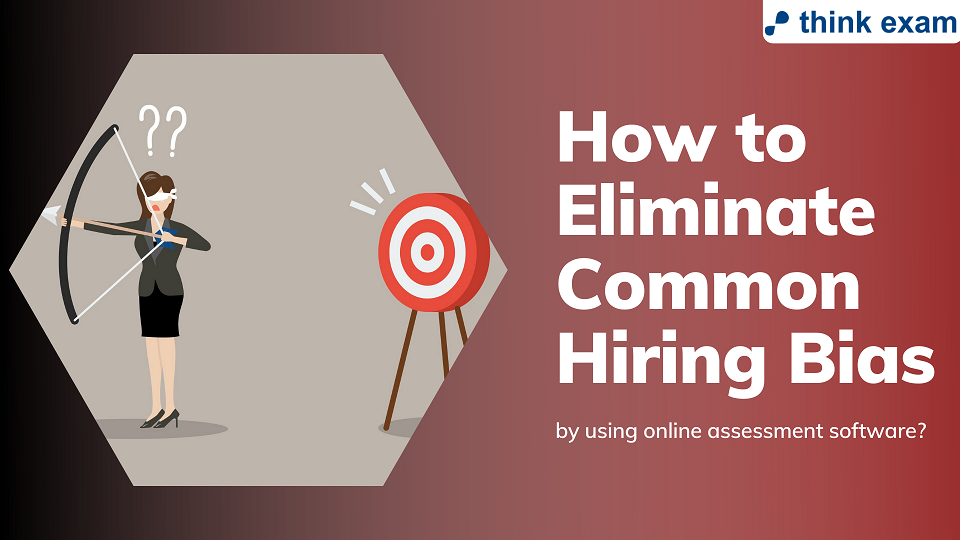[responsivevoice_button buttontext=”Listen to the Audio Version”]
“Humans are capable of making decisions in as little as a third of a second. Also, in a day, humans can make up to 35,000 decisions, many of which are done subconsciously.”
After all, we are the result of our decisions…
Now let’s talk about the influence of decisions in the process of hiring. The recruiters are no robots and no matter how professional they are, still, bias has got the power to cloud their decision. To eliminate this drawback corporates are adopting the technology of online assessment software which is effectively countering the bias factor.
A brief overview of the types of common hiring bias
Confirmation bias
“Confirmation bias- hunting for information that confirms our initial assumptions (which are often self-serving)”
We are all a prisoner of our beliefs but it gets worse when we bring confirmation bias in action. To intentionally ask questions and then interpret them in a manner that justifies your belief is what confirmation bias does. Recruiters make prior beliefs about the candidates based on various reasons and then ask questions that can indirectly support their belief.
This is one of the many reasons how recruiters tend to loose on potential candidates all because they had wrong (justified) beliefs about the candidate.
Affect Heuristics
It is a mental shortcut that lets people come to an instant decision under certain emotional circumstances such as- fear, pleasure, surprise, etc.
Often, recruiters make decisions based on superficial factors that hold no scientific or logical explanation as to how the candidate is perfect for the job role.
Halo effect
“What really counts VS what catches the eyes…”
This is the most common type of bias where the recruiters get influenced by the looks, dressing style and speaking manner of the person. The influence is mostly positive and the recruiters ignore the negative parts of the personality or job unsuitability all because of attractive looks or catchy dressing style.
Horn effect
The complete opposite of halo effect, horn effect is when the recruiters consider some negative part of the personality or looks of the candidate. Because of the entire focus on that negativity, the positives or job suitable skills of the candidate entirely get ignored.
Overconfidence bias
This happens when recruiters think too highly of their decision-making skills because of which they bring in effect the confirmation bias. Without going through the entire skills and knowledge of the candidate, recruiters instantly come to the decision that their first judgment is right.
Similarity attraction bias
People who have some level of background similarity tend to attract each other. Similar religion, name, family background, characteristics, and many other factors are there that initiate similarity attraction bias.
Recruiters are also no exception to it and unconsciously get attracted to candidates who have some sort of similarity with them.
A study made by Harvard business review stated that “when there is a candidate ratio of 3 women over 1 man then the likelihood of hiring a woman candidate increases by 67%. When the candidate ratio is 2 women and 2 men then the likelihood of hiring a woman becomes 50%. And, when the candidate ratio is 3 men over 1 woman then the likelihood of hiring a woman becomes 0%.”
Online exam software, when used for recruitment process, is highly useful. After learning about all so many biases it is right to say that pre-employability tests are the ultimate resolve for all of them.
What are the types of pre-employability tests to eliminate bias factors that recruiters can create using online exam software?
- 》 Job Knowledge tests– These types of tests are designed by the recruiters to get an insight into the theoretical and technical job-related knowledge of the candidates.
- 》 Integrity tests– To predict job performance and integrity of the candidates, these tests are created. Questions related to integrity and ethics mainly constitute the test.
- 》 Cognitive ability tests– To measure mental capacity which is mainly related to the job role, cognitive ability tests are created. They mainly assess the logical, verbal and numerical reasoning of a candidate.
- 》 Personality tests- Fitting into a job role and becoming culturally fit… well, there is a difference between the two. Any candidate who has got the required skills can fit into the job role but if he/she is culturally unfit then job space becomes uncomfortable to work for the person. Personality tests ascertain the availability of required personality according to the job role that makes the candidate more preferable for the given profile.
- 》 Emotional Intelligence tests- Professions that involve enhancing interpersonal relationships or dealing with clients require high emotional intelligence. Emotional intelligence tests are a reflection of a person’s EI which is equally important to test as any other skill-based test.
- 》 Skills assessment tests– Job-related soft skills and hard skills of a candidate are assessed through this test. Other types of tests that are related to skill-based tests are- leadership tests, data checking tests, presentation tests.
“According to research, 70% recruiters use job skill tests; whereas 46% of the recruiters use personality and psychological tests, and 41% recruiters use basic literacy and math skill tests.”
Out of many reasons for using pre-employability tests, one main reason is to reduce bias factor and now we all know why. Luckily, recruiters are blessed with the power of technology in the form of online exam software that lets them create any type of pre-employability test with ease.








